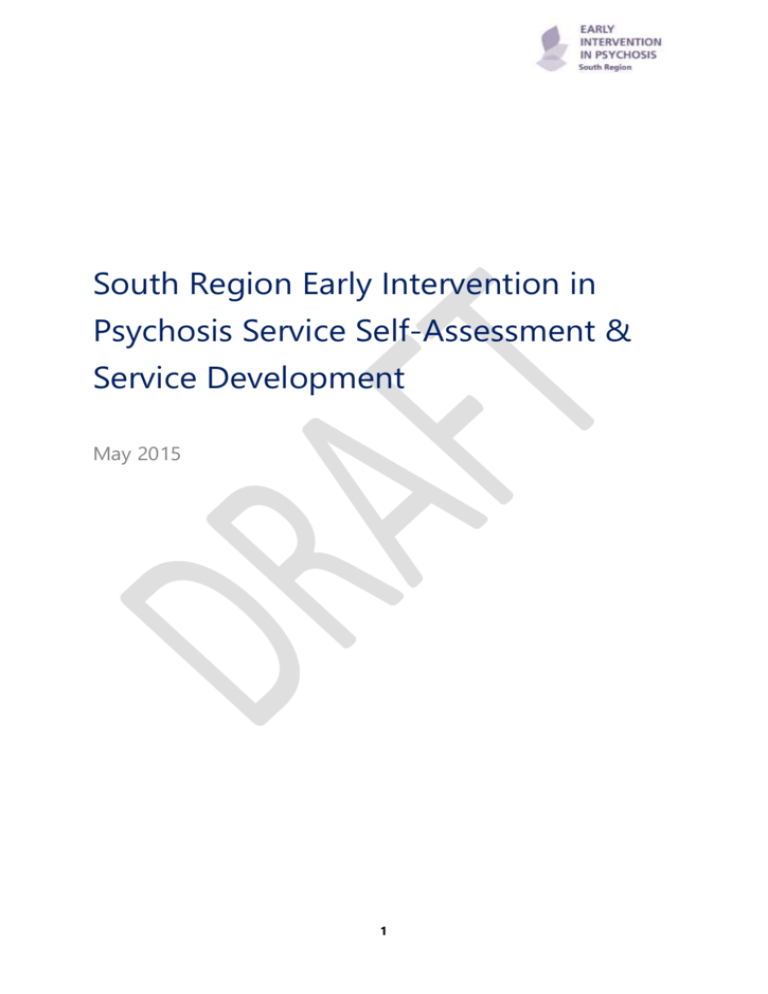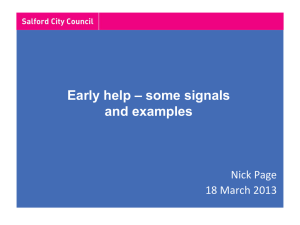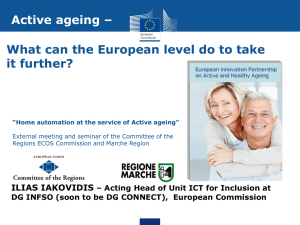The Early Intervention in Psychosis Service Development
advertisement

South Region Early Intervention in Psychosis Service Self-Assessment & Service Development May 2015 1 Contents The Early Intervention in Psychosis Service Development Framework ....... 3 Using the Self-Assessment & Action Planning Tool ........................................ 3 Section 2: NICE Concordance ....................................................................................... 5 Section 3: Performance & Outcomes ........................................................................ 6 Section 4: Workforce and Training ............................................................................. 8 Section 5: Scoring Matrix ............................................................................................... 9 Section 6: EIP Preparedness Summary & Action Plan ...................................... 12 2 The Early Intervention in Psychosis Service Development Framework The fidelity with which an intervention is implemented affects how well it succeeds i. For instance, two studies examining programmes to help people with mental health issues obtain employment found that employment outcomes among their study groups were weakest for those in poorly implemented programmesii. Achievement of high fidelity is one of the best ways of replicating the success of interventions achieved by research that has led to NICE guidelines. This Service Development Framework is aimed at helping NHS foundation trusts, NHS trusts and commissioners to understand the fidelity and performance of their EIP servicesiii. The framework is based on evidence drawn from: 1. 2. 3. 4. NICE guidelines for Psychosis and Schizophrenia based on proven efficacy, effectiveness and acceptance Expert opinions gathered through surveys of experts and literature reviews Opinions of users of EIP and their advocates regarding what works Site visits to a range of EIP services across the UK Using the Self-Assessment & Action Planning Tool The aim of the South Region EIP Preparedness Programme is to support organizations in identifying opportunities to develop their EIP services for improved outcomes for people with first episode psychosis. The framework contains a set of general indicators for organisations to consider, followed by four more detailed sections: 1. About you 2. NICE Concordance 3. Performance & Outcomes 4. Training and Workforce Development 5. Summary & Action Plan Each section is intended to support organizations in assessing the extent to which EIP is successfully embedded on a scale of 1 to 3: 1. Little evidence of a successfully embedded EIP service - Bronze 2. Some evidence of a successfully embedded EIP service - Silver 3. Strong evidence of a successfully embedded EIP service - Gold 3 Section 1: About You Field Name: Free Text Role: Name of Trust/Organisation: Name of Early Intervention in Psychosis Service: Number of people with first episode of psychosis currently being served by EIP service in the following age ranges: Contact Details: Address: Email: Telephone number: 4 0-18 years old 19-35 years old 36-60 years old Section 2: NICE Concordance The provision of NICE recommended treatments for psychosis and schizophrenia Indicator Indicator 2.1 – Cognitive Behavioural Therapy (CBT) Number of people with psychosis or schizophrenia on the EIP caseload with evidence of receiving Cognitive Behavioural Therapy (CBT) Indicator 2.2 – Family Intervention Number of people with psychosis or schizophrenia in EIP with family members, who received family intervention, family work or family therapy Indicator 2.3 –Clozapine Number of people with psychosis or schizophrenia in EIP who have not adequately responded to treatment with at least 2 antipsychotics, who are prescribed Clozapine Indicator 2.4 – Vocation Number of people with psychosis or schizophrenia on the EIP caseload who are receiving support to gain or retain their employment and/or education Indicator 2.5 – Physical Health Number of people with psychosis or schizophrenia on the EIP caseload with evidence of receiving a physical health check, including: Pulse, BP, Lipids, Glucose, Weight, Waist Circumferenc Indicator 2.6 – Smoking Number of people with psychosis or schizophrenia on the EIP caseload who smoke with a record of being offered smoking cessation support in the last year Indicator 2.7 – Carers Number of carers of people with psychosis or schizophrenia on the EIP caseload who are offered carer-focused education and support programmes e.g. Carer’s Assessment, Respite, Carers Support Group, Family Work 5 Level 1 Level 2 Level 3 Section 3: Performance & Outcomes EIP services must ensure that <50% of people referred for first episode psychosis receive a NICE package of care within 14 days of referral. Services must continuously strive for the best possible outcomes for those accessing their services. Indicator Indicator 3.1 – Access Number of people with psychosis or schizophrenia who are seen by the EIP service, as compared to predicted cases of psychosis in your area (www.psymaptic.org) Indicator 3.2 – Duration of Untreated Psychosis (DUP) Number of people on the current EIP caseload with a DUP of 0-29 days 30-59 days 60-89 days 90 days of more Indicator 3.3 - Duration Without Early Intervention Number of people with psychosis or schizophrenia on the EIP caseload with a length of psychotic symptoms before allocation to an EIP care coordinator spanning: 0-29 days 30-59 days 60-89 days 90 days or more Indicator 3.4 – Waiting Time Number of people with psychosis or schizophrenia allocated an EIP care coordinator within 14 days after referral Indicator 3.5 – Admission Rates Number of people with psychosis or schizophrenia under an EIP team admitted to a mental health acute ward in the past 12 months 6 Level 1 Level 2 Level 3 Level 4 Indicator 3.5.1 – Informal Admissions Number of people with psychosis or schizophrenia under an EIP team admitted to a mental health acute ward informally Indicator 3.5.2 – Informal Admissions Number of people with psychosis or schizophrenia under an EIP team admitted to a mental health acute ward formally under the Mental Health Act Indicator 3.5.3– Bed Stay Number of people with psychosis or schizophrenia under the care of an EIP team admitted to a mental health acute ward who are admitted for 28 days or more Indicator 3.5.4 – Readmissions Number of people with psychosis or schizophrenia under an EIP team who were re-admitted to a mental health acute ward within 30 days or less of discharge Indicator 3.7 – Employment Number of people with psychosis or schizophrenia in employment (paid, unpaid, part or full time and voluntary work) or education Indicator 3.9 – Accommodation % of people with psychosis or schizophrenia in settled accommodation Indicator 3.9 – Recovery Rates Number of people with psychosis or schizophrenia discharged to a primary care or third sector provider who have no contact with secondary mental health services 12 months after discharge from EIP 7 Section 4: Workforce and Training Clinicians must have the time, knowledge, attitude and skills to provide care based on best practice evidence Indicator Indicator 4.1 – Team Capacity What is the total number of clinicians and allied health professionals (including pharmacists, support workers etc) currently working in your EIP team? (please do not include admin staff for this indicator) Indicator 4.2 – Consultant Psychiatrists Whole Time Equivalent (WTE) of Consultant Psychiatrist time dedicated to the EIP service Indicator 4.2.1 – Staff Grade Psychiatrists Whole Time Equivalent (WTE) of Consultant Psychiatrist time dedicated to the EIP service Indicator 4.3 – Consultant Psychologists WTE of Consultant Psychologist time dedicated to the EIP service Indicator 4.3.1 –Psychologists WTE of Psychologist time dedicated to the EIP service Indicator 4.4 –Team Managers WTE of Team Manager time dedicated to the EIP service Indicator 4.5 –Care Coordinators (>Band 6) WTE of the EIP team who have care coordinating responsibilities 8 Level 1 Level 2 Level 3 Indicator 4.6 – Clinicians with a Foundation Qualification in Cognitive Behavioral Therapy (CBT) WTE of EIP clinicians who have been trained in CBT for common mental health problems or a similar CBT foundation course Indicator 4.7 – Clinicians with Cognitive Behavioral Therapy (CBT) for Psychosis Qualification WTE of EIP clinicians who have attained externally validated competency (through a University Post Grad Diploma or Degree or Masters) in delivering CBT for Psychosis Indicator 4.8 – Family Interventions WTE of all EIP clinicians who have attained post graduate diploma, degree or masters competency in Family Work/Family Interventions via a training programme such as Psycho-Social Intervention (PSI) or THORN Indicator 4.9 – Vocational Support WTE of EIP staff working as Support Workers with accredited Individual Placement and Support (IPS) training or equivalent Section 5: Scoring Matrix Section Field Section 1 First Name, Last Name*: About you Your Role*: *Mandatory Fields Organization/Trust*: Free Text Address*: E-mail*: 9 Telephone*: Total EIP Caseload*: Calculating Total Average Levels Section 2 & 3 NICE Concordance & To determine the percentage for each sub-indicator e.g. indicator 2.1, the inputted number should be divided by the total number of people accessing the EIP team. This figure should be multiplied by 100 to get a percentage which will indicate a level for each sub-indicator e.g. Indicator 2.1 = 51% = Level 2 = a Silver Service. Performance Sections 4 Workforce & Training Section To determine the percentage for each indicator e.g. indicator 2.1, the inputted number should be divided by the total number of people working in the EIP team. This figure should be multiplied by 100 to get a percentage which will indicate a level for each indicator e.g. Indicator 2.1 = 51% = Level 2 = a Silver Service. Indicator Percentage Level Percentage Level Percentage Section 2 2.1 0-50% 51-80% 81-100% NICE Concordance 2.2 0-50% 51-80% 81-100% 2.3 0-50% 51-80% 81-100% 2.4 0-50% 51-80% 81-100% 2.5 0-50% 2.6 0-50% 51-80% 81-100% 2.7 0-50% 51-80% 81-100% 1 51-80% 10 2 81-100% Level 3 Section 3 3.1 0-50% 51-80% 81-100% Workforce and Training 3.2 0-50% 51-80% 81-100% 3.3 0-50% 3.4 0-50% 51-80% 81-100% 3.5 0-50% 51-80% 81-100% 3.6 0-50% 51-80% 81-100% 3.7 0-50% 51-80% 81-100% 3.8 0-50% 51-80% 81-100% Section 4 4.1 0-50% 51-80% 81-100% Performance & Outcomes 4.2 0-50% 51-80% 81-100% 4.3 0-50% 51-80% 81-100% 4.4 0-50% 51-80% 81-100% 4.5 0-50% 51-80% 81-100% 4.6 0-50% 4.7 0-50% 51-80% 81-100% 4.8 0-50% 51-80% 81-100% 4.9 0-50% 51-80% 81-100% 1 1 51-80% 51-80% 11 2 2 81-100% 81-100% 3 3 Section 6: EIP Preparedness Summary & Action Plan The below scoring matrix (page 12) will provide a summary or the EIP service’s development level on a scale of 1 to 3: 1. Little evidence of a successfully embedded EIP service - Bronze 2. Some evidence of a successfully embedded EIP service - Silver 3. Strong evidence of a successfully embedded EIP service – Gold The summary page will list the areas with the most and least achievement with a prompt for the user to address the areas of least achievement. The summary page will also list the indicators with against which the user has scored highest; this will be used to reinforce and share good practice. Organizations will be asked to use the framework findings to inform their Preparedness Action Plans. The EIP Preparedness Programme Board will review each organization’s EIP Preparedness Action Plan to ensure it reflects the organisation’s findings and priority areas for allocating the Preparedness funds. Indicator e.g. 2.1 Summary Average score indicates little/some/strong evidence of a successfully embedded EIP service with a rating of Bronze/Silver/Gold The highest scores were against indicators XXX whilst indicators XXX showed the most need for improvement Action Who By Initiation Date Dusenbury L, Brannigan R, Falco M, Hansen W: A review of research on fidelity of implementation: Implications for drug abuse prevention in school settings. Health Educ Res 2003, 18:237-256. i Dane A, Schneider B: Program integrity in primary and early secondary prevention: Are implementation effects out of control. Clin Psychol Rev 1998, 18:23-45. ii Elliot D, Mihalic S: Issues in disseminating and replicating effective prevention programs. Prev Sci 2004, 5:47-53 iii 12 Completion Date






